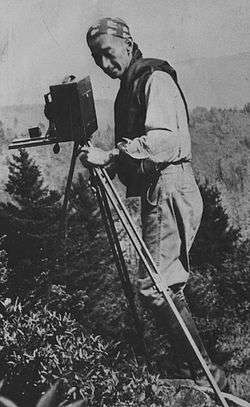George Masa

George Masa (1881 - June 21, 1933), born Masahara Izuka, in Osaka, Japan,[1] was a businessman and professional large format photographer.
Creating a new life in America
Masa arrived in the United States in 1901.
In 1915, he settled in Asheville, North Carolina, where he would spend the final 18 years of his life.
After initially working for the Grove Park Inn as a bellhop and valet, Masa left the inn to take a position as a photographer in February 1919. Eventually, he founded Plateau Studio (a business he later sold, which is still in operation today).[2] His customers included some of the town's most affluent citizens such as the Vanderbilt, Grove, and Seely families.
The Great Smoky Mountains
Masa came to love the mountains of Western North Carolina and worked tirelessly for their preservation - at his own expense. Using his photographic equipment and an odometer he crafted from an old bicycle,[3] Masa meticulously catalogued a significant number of peaks,[4] the distances between them, and the names given to them by the local settlers and the Cherokee.[2] He was a friend of Horace Kephart [5] and the two of them worked together to ensure that a large portion of the Great Smoky Mountains would be established as a national park. Masa also scouted and marked the entire North Carolina portion of the Appalachian Trail.[6]
Death and legacy
Masa died in 1933 from influenza. He sincerely desired to be buried next to his friend Kephart near Bryson City, North Carolina,[7] but was instead buried in Asheville's Riverside Cemetery.[7]
One year after Masa's death, the Great Smoky Mountains National Park was officially established.[7][8]
In 1961, Masa Knob, a peak of 5685 feet[9] in the Great Smoky Mountains National Park, was named in Masa's honor.[7][10] It stands, appropriately, adjacent to Mount Kephart.
Documentaries
Interest in Masa's life was revived by documentary film-makers more than 60 years after his death. Bonesteel Films released a 90-minute documentary about George Masa in 2003.[11] Also, Ken Burns' multi-part documentary about "The National Parks: America's Best Idea" features George Masa in the fourth episode (1920–1933) which was initially broadcast on September 30, 2009.[12]
See also
Notes
- ↑ "George Masa - Hunter Library, Western Carolina University". Retrieved 2015-04-14.
- 1 2 The Mystery of George Masa (Documentary). Asheville, North Carolina: Bonesteel Films. 2003.
- ↑ "George Masa Collection - Highlands Historical Society". Retrieved 2007-04-01.
- ↑ "George Masa Papers - Ramsey Library, University of North Carolina at Asheville". Retrieved 2011-02-21.
- ↑ "Horace Kephart - Revealing an Enigma, Hunter Library, Western Carolina University". Retrieved 2007-10-05.
- ↑ "The Mystery of George Masa - Bonesteel Films". Retrieved 2007-04-02.
- 1 2 3 4 "A hike with a bit of history", The Smoky Mountain News, 13 July 2005.
- ↑ American Park Network - GSMNP.
- ↑ "Masa Knob - wayhoo.com". Retrieved 2007-04-02.
- ↑ "Carolina Mountain Club Archive - Ramsey Library, University of North Carolina at Asheville". Archived from the original on 2007-02-16. Retrieved 2007-04-02.
- ↑ "The Mystery of George Masa - Bonesteel films". Retrieved 2007-04-02.
- ↑ Ken Burns, PBS, "The National Parks," – People Behind the National Parks, George Masa
References
- Duncan, Dayton and Ken Burns. (2009). The National Parks: America's Best Idea. New York: Alfred A. Knopf. ISBN 978-0-307-26896-9; OCLC 290466894. Two useful biographical vignettes of Masa are William A. Hart's "George Masa: The Best Mountaineer," in Robert S. Brunk (Editor), May We All Remember Well," Volume I, pages 249-75 and Jim Casada, "George Masa: Musings on a Man of Myster," Smoky Mountain Living," Fall, 2001, pages 67–70.
External links
- Ken Burns, PBS, "The National Parks," – People Behind the National Parks, George Masa
- Paul Bonesteel, Bonesteel Films, "The Mystery of George Masa"